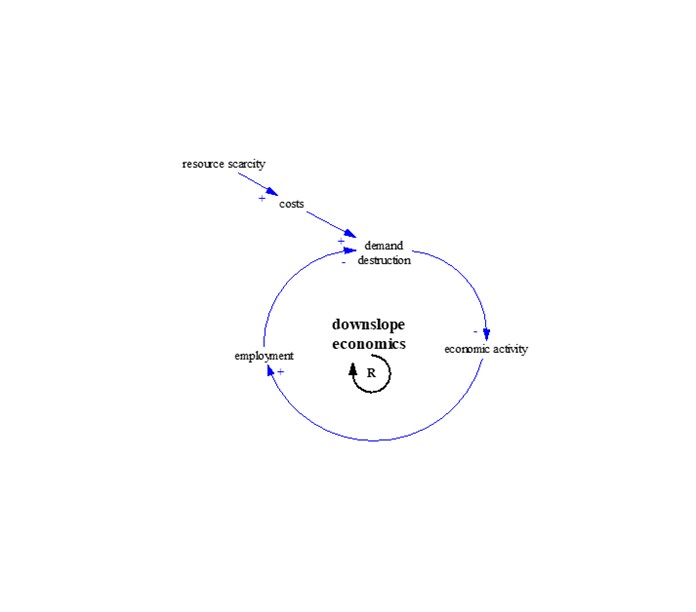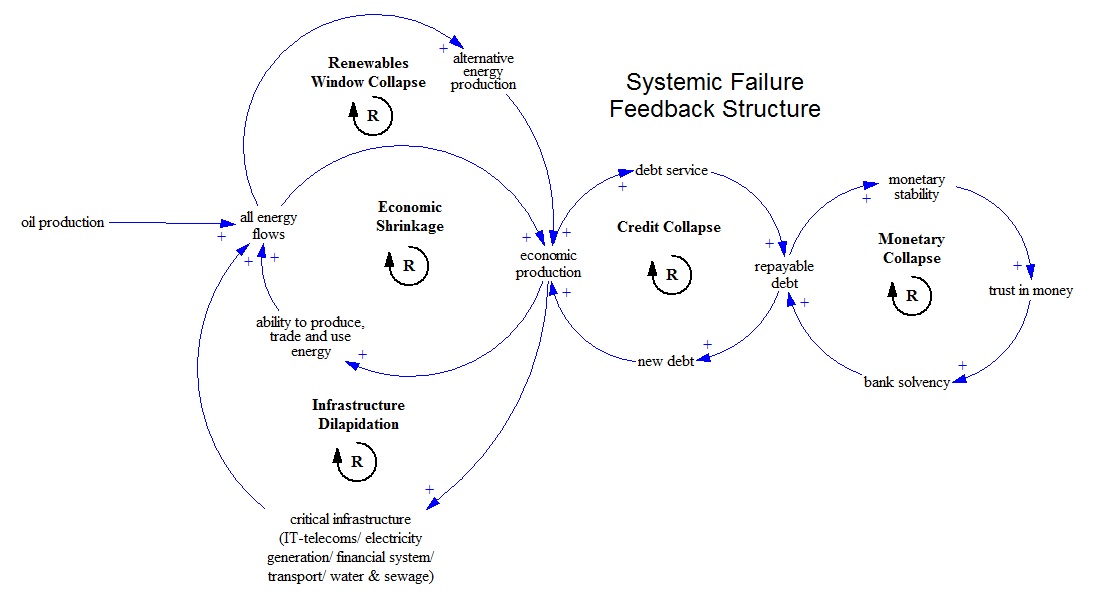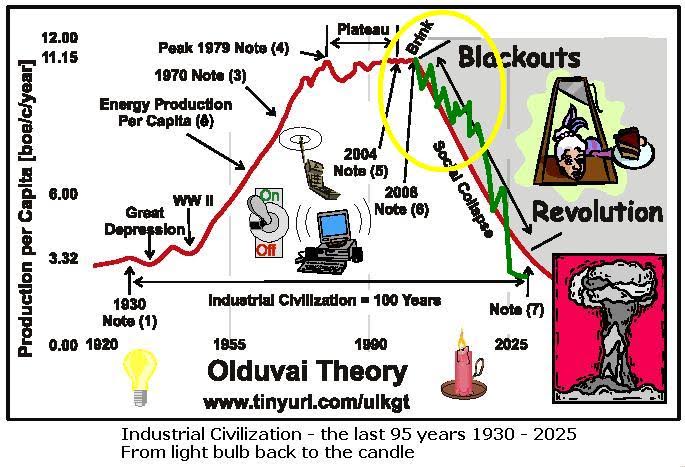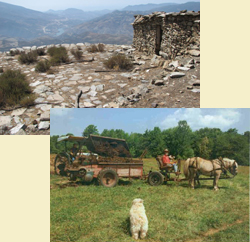« What Is the Deep State? | Home | Biochar – a Critical View Through the Ecosystemic Lens »
Scenarios on the Downslope: Insights from Greer’s The Ecotechnic Future
By Karl North | September 17, 2017
Perhaps the hardest truth for modern society on the edge of industrial decline is to learn our species’ dependence, like other species, ultimately on natural laws, not human ones. The learning process has many layers, partly because it involves a revolution that takes us beyond reductionism to seeing reality in a more systemic and historical context. H.T. Odum’s general systems theory demonstrates that dynamics in all living systems are governed by the same laws: laws of energy and matter and ecosystem processes on which the durability of all living systems depends. Once we see that human society is a subset of a larger ecological whole, then it becomes clear that the laws and disciplinary concepts and principles of ecology are essential tools for social inquiry. In The Ecotechnic Future: Envisioning a Post-Peak World, John Michael Greer elaborates ways this systemic worldview and principles from the study of natural ecosystems offer insights on the evolution of collapse of industrial civilization.
In earlier work Greer described the process as one of catabolic collapse, a kind of metabolism, defined as a process of conversion of resources to maintain and perhaps grow living systems. A metabolism that no longer has the resources to achieve this result begins to feed on itself: it goes into catabolic collapse. This is the metabolism of shipwrecked people in a lifeboat without food; the more obese tend to live longer, feeding on their own fat. Following general systems theory, Greer applies this concept at all levels from living cells to civilizations. In The Ecotechnic Future, Greer applies the concept of succession from ecosystem science to describe a framework for thinking about the catabolic collapse of industrial civilization. In this essay, I will summarize the ecology of succession (which should be familiar to students of elementary systems ecology) and then show how it provides a rough guide to thinking about scenarios on the downslope. Those people who can see likely scenarios and begin adapting will be the most likely survivors.
Ecologists observe succession as a long process of trial and error as ecosystems and their inhabitants adapt to changing conditions, mostly brought on by the residents themselves. For any given environment, succession follows a pattern of somewhat predictable stages called seres in which ecosystems reorganize into new communities, adding new species and losing others in response to changing conditions. Conditions in early seral stages select for fast growing species that make inefficient use of resources, called R-selected species. Plants that typically sprout in tilled soil, which farmers call weeds, are examples of R-selected species. Most crops, being fast-growing annuals, are R-selected. Conditions of competition for resources in later stages select for species that make slower, more efficient use of resources, called K-selected species. The degree of system stability at each stage hangs on how well the species integrate into a system of interdependency – how well the species ‘hang together’.
Following general systems theory, we should be able to see succession operating in human ecosystems. In modern civilization, the adoption of fossil energy made available a bonanza of resources. Thus, the industrial revolution generated an explosion of R-selected forms akin to species in early seral stages of nonhuman ecosystemic succession. After the R-selected growth of earlier industrial society, resource depletion and diminishing returns to technological innovation began a succession of seral stages toward human ecosystems selected for K-selected forms as industrial society fades away. Greer’s description of the process identifies and elaborates three seral stages of catabolic collapse:
- The end of affluence – 1970 to at least the present time.
- Age of scarcity industrialism – industrial economies are gradually forced to adapt to resource scarcity.
- Age of salvage – embodied energy in the built environment allows a gradual decline but depends a lot on how much information is salvaged.
If all goes well, survivors will evolve an ecotechnic society where they have adopted technologies that are adapted to the remaining resources and obedient to the laws of nature. At the same time, seral stages are bottlenecks through which only a portion of previous population passes. Just as certain species survive the transition and new ones take hold in natural ecosystem succession, seral transition to the age of salvage for example will favor certain types of people – like blacksmiths over software engineers – and eliminate others.
Important to the succession concept as applied to human society is the understanding that each stage is not just a chaotic one of things falling apart but represents a process of forced or chosen reorganization of the social system around the new conditions. Depending on the ability of policy making to be proactive at different levels of scale, each seral stage represents an opportunity to achieve a degree of mitigation of collapse – a degree of temporary sustainability built around a lower material resource base. Just as a given species configuration in non-human ecosystems eventually no longer works, and one seral stage supplants another, so the inevitable catabolic process in the industrial downslope gradually renders each configuration of policies obsolete and a new type of social organization will succeed the previous one. Barring catastrophic events, society will pass through each seral stage. Hence it is useful to consider the probabilities and possibilities at each stage. In what follows I will sketch a rough outline of each stage.
The end of affluence – 1970 to present
Drawing on his broad historical knowledge, Greer describes the way all collapsing civilizations have clung as long as possible to the way of life at their peak, and suggests that will be the most likely pattern of society’s response throughout the age of the end of affluence. The almost complete denial occurring today will likely continue for several years, although financial collapse could cut it short. Characteristic of this stage is a reinforcing loop of demand destruction in response to increasing resource scarcity and rising costs, starting in the lower classes, resulting in lower economic activity, less employment and eventually more demand destruction. This positive feedback loop is already operating. Demand destruction starts with the least necessary consumption; industrialized society gradually lets go of its immense overload of discretionary consumption and waste. This built-in slack (in the sense of ‘cut me some slack’) provides the opportunity for gradual adaptation to new definitions of necessity.
Age of scarcity industrialism
As industrial economies are gradually forced to adapt to resource scarcity, the props and tricks used to maintain the appearance of affluence – extreme debt financing, deliberate infrastructure dilapidation, war economies, etc. - not only no longer work, they have left society in a more fragile state.
Hence the age of scarcity industrialism is increasingly prone to what in ecosystem science is called a trophic cascade. Ecosystems are trophic webs – food webs of interdependency where each species is food for others. As predator species keep prey populations in check they serve a homeostatic regulatory function that tends to give the whole system a degree of dynamic equilibrium. Thus a serious disturbance in one species population can have repercussions throughout the food web. Ecologists have identified keystone species, ones whose role is so important that a major change in a keystone species population can cause populations of others to alternatively crash or explode down a chain of predator-prey relationships. This trophic cascade can reduce the whole system to a lower seral stage of succession.
Greer suggests that we can use the concept of trophic cascade to think about dynamics in modern society as it becomes more fragile in the age of scarcity industrialism. Because human societies are also systems – where in this instance economic, political and cultural elements are structured in webs of interdependence – a major disturbance or collapse in one element can cause a cascade that collapses whole chains of elements. As an example, here is my summary in a causal loop diagram of a commonly cited scenario.
As resource scarcity causes the economy to shrink, demand destruction deepens and the impoverishment it brings to the majority increases. Hence the ruling class is likely to employ greater government intervention in the economy, more or less in the following ways depending on the competence of rulers and in the following priority:
- To maintain the prosperity of the upper classes amid declining resources.
- To pacify suffering urban populations by providing basic necessities of life. Example: German National Socialism and Italian fascism.
- To reconfigure the political economy toward a new seral stage that favors K-selected forms that are adapted to the end of growth and increasing resource-scarcity.
The social costs to human welfare in this process depend on how intelligently society responds to increasing scarcity. The longer industrial society clings to present forms, the greater the damage. As Greer states,
In the near term, societies that embrace scarcity industrialism, relying on efficient use of remaining fossil fuels and eking them out with renewable resources and high technology, will likely do better than either the wasteful abundance economies of the present or the more sustainable cultures that will replace them.
The “wasteful abundance” thus represents some slack where remaining industrial potential could be differently used to cushion the downslope during this period.
Other writers have contributed to the discussion of scenarios of adaptation in the age of scarcity industrialism. Alice Friedemann’s short summary is a good place to start: http://energyskeptic.com/2017/transportation-how-long-can-we-adapt-before-we-fall-off-the-net-energy-cliff/
Age of salvage
Depletion and damage to the resource base is likely to be so great at this stage that its carrying capacity for a human population will be low. However, depopulation eventually provides a period of relief from resource scarcity. And as reliance on new raw materials extraction comes to an end, the crumbling material remains of the industrial age represent an accumulation of emergy (embodied energy) that cushions the decline. Salvage steel, for example embodies all the energy of mining, processing and long-distance transport. Thus, the accumulated emergy of salvage allows a gradual decline but depends a lot on how much information is salvaged. Medieval Europe enjoyed the durable roads and aqueducts of Roman civilization for a long time but lost techniques like making concrete. As in Kunstler’s World Made by Hand saga, islands of knowledge conservation may permit local, small electricity generation to continue for a while. This in turns allows some salvage use of electrical appliances.
Society will reorganize in this seral stage. Resource nationalism and urban concentrations of salvage materials will push production, transport and trade into new more localized forms. Central control, either private or government, will weaken as it becomes unaffordable. Whatever social policies emerge will likely be created by local communities struggling to define themselves.
Ecotechnic age
Considering that it is the title of his book, Greer has little to say about life in this age, except that society will become agrarian again and whatever technologies exist will conform to the laws of thermodyamics. Barring a predator species to hold its population in check, humanity may again violate the law of carrying capacity. But a largely eroded planetary carrying capacity will keep new population peaks relatively low. Agriculture will reorganize around staple food production that favors R-selected perennials over annual species. Peasant populations that never could afford much of the prosperity of the industrial age retain and still practice a cultural heritage of technical knowledge from pre-industrial times. This will give them an advantage over other populations in this seral adaptation.
Criticisms of Greer’s gradual decline thesis.
A number of energy descent writers have questioned Greer’s claims of a slow collapse over several centuries. In The Ecotechnic Future, Greer projects a slow collapse even in the near term. He uses the original Hubbert bell curve, calculating that from an oil peak in 2005, production in 2030 will equal production in 1980, and production in 2060 will still equal production in 1950. This is deceptive, as it ignores the so-called Seneca cliff popularized by Udo Bardi, according to which declining EROEI and the costs of pollution will create a steeper down slope – an asymmetric bell curve. Surely Greer knows this, as the idea is as old as Richard Duncan’s 1989 Olduvai Theory of collapse.
In my view, Greer also fails to fully apply his own notion of a trophic cascade to identify the civilizational counterparts of keystone species, disturbance of which is likely to accelerate collapse. For example, Duncan and others have claimed that prolonged electrical grid failure can cause cascading failure of the industrial economy, like trophic cascades discussed above that ecologists have documented in non-human ecosystems. Others have pointed to the ability of financial system failure, major supply chain failure triggered by a war, natural disaster or other major shocks to spark a cascading general collapse of the global economy. A paper by David Korowicz, summarized by Alice Friedemann is the best I have seen on this subject. http://energyskeptic.com/2012/david-korowicz-tipping-point-near-term-systemic-implications-of-a-peak-in-global-oil-production/. I modeled some of the positive feedbacks responsible for those cascades in The Case for a Disorderly Energy Descent.
I also think Greer places too much faith in the ability of society to reorganize at each seral stage. He cites evidence from nonhuman ecosystems and historical evidence from collapsing civilizations. For example, as the Roman Empire fell, the breakdown of social order became so great that Western Europe was almost completely cut off both from the accumulated cultural heritage of Rome and the other ancient civilizations, and from thriving economies elsewhere. Yet Frankish warlords and eventual monarchs under strict tutelage from a totalitarian church managed to reorganize a somewhat stable society out of the chaos. However, life before and after the fall of Rome was still agrarian, so the change was not great. By contrast, as industrial civilization falls, most people have none of the skills to survive in the agrarian existence that collapse will impose. Complete social disorder could happen relatively quickly; chaotic social conditions could last a long time, and little reorganization could ever take place. Greer avoids dramatizing the inevitable suffering. Fair enough. However, the breakdown of elemental security and social order will be a major factor deciding what is possible in all of his stages of collapse, and should have been accounted for in his analysis.
Conclusion
Despite above criticisms, I think The Ecotechnic Future offers useful concepts from ecosystem science to frame thinking about how the decline of the industrial age will evolve.
Topics: Political and Economic Organization, Social Futures, Peak Oil, Relocalization, Uncategorized | No Comments »



